Contact Mazarrón Tourist Office +34 968 59 44 26
or send an Email
Click HereContact Mazarrón Tourist Office +34 968 59 44 26
or send an Email
Click Here


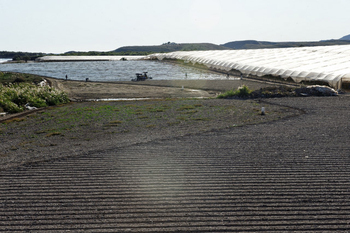 The outlying village of Cañada de Gallego is 11 km from Mazarrón, and in terms of population it is one of the largest in the municipality with 1,213 inhabitants, according to the municipal Padrón in 2021. Many of these inhabitants are of northern African and South American, making up the workforce on the large tomato plantations, although there are also 50 or so northern European expats in the area.
The outlying village of Cañada de Gallego is 11 km from Mazarrón, and in terms of population it is one of the largest in the municipality with 1,213 inhabitants, according to the municipal Padrón in 2021. Many of these inhabitants are of northern African and South American, making up the workforce on the large tomato plantations, although there are also 50 or so northern European expats in the area.
The biggest population centre is Ifre-Gallego, which until 1970 was a single entity combined with Pastrana. For this reason both villages are found with the prefix "Ifre".
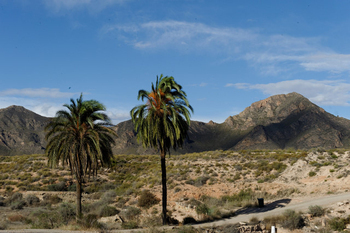 Cañada de Gallego lies between the coast and the mountains of Sierra de las Moreras, and was home to human settlers as early as the Middle and Late Paleolithic Age, which covers (between 300,000 and 10,000 BC). The material culture found in the area shows that various tools were made, including flint blades, scrapers and hole-punching tools. There is a cave in Percheles which shows evidence of human habitation in the Neolithic (between 6000 and 3000 BC).
Cañada de Gallego lies between the coast and the mountains of Sierra de las Moreras, and was home to human settlers as early as the Middle and Late Paleolithic Age, which covers (between 300,000 and 10,000 BC). The material culture found in the area shows that various tools were made, including flint blades, scrapers and hole-punching tools. There is a cave in Percheles which shows evidence of human habitation in the Neolithic (between 6000 and 3000 BC).
This is when Man first started to live in permanent settlements, attracted to places by the natural resources available and generally living in caves or natural rocky shelters. Signs of this early habitation include fragments of flint, sea shells and crude handmade ceramics.
Since then Mazarrón has been home to various different cultures, including the Argaric, a culture which spread from Almeria and was present in certain parts of Southern Spain between 1800 and 1300BC , before being absorbed by subsequent population migrations. Clear evidence of the Argaric and the subsequent Iberian culture has been found in the Sierra de las Moreras.
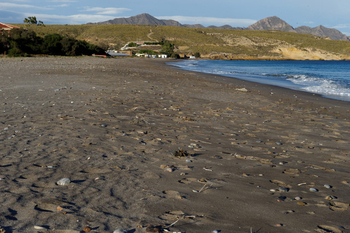 Later there were also the Phoenicians from the Eastern Mediterranean, who came here between 800 and 500 BC attracted by the mineral wealth of the area and also set up fish salting plants. They left behind several traces of their presence, in particular two boats which sunk in the bay of La Isla, one laden with ingots which could well have come from the Mazarrón mines, and the other leaving ceramic fragments on the seabed which point to fish salting activity.
Later there were also the Phoenicians from the Eastern Mediterranean, who came here between 800 and 500 BC attracted by the mineral wealth of the area and also set up fish salting plants. They left behind several traces of their presence, in particular two boats which sunk in the bay of La Isla, one laden with ingots which could well have come from the Mazarrón mines, and the other leaving ceramic fragments on the seabed which point to fish salting activity.
The Romans, who arrived after them, also took advantage of Mazarrón's resources and the population grew on the back of fishing, agriculture and mining. Among the legacy they left are the remains of mine workings, villas and a fish salting factory .
Most of the archaeological evidence in Cañada de Gallego has been found at the beach of Percheles, the site of a Roman villa (although there is no structure visible today). This villa is thought to have been been used for fishing, agriculture and the production of purple dye extracted from molluscs.
During the Moorish occupation which followed the decline of the Roman Empire until the 13th century there were certainly settlers within the municipality but there are no known remains in Cañada de Gallego itself.
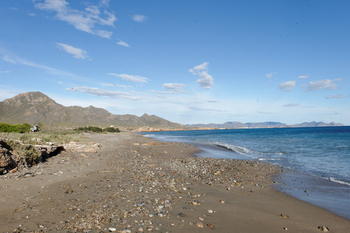 Following the Christian Reconquista in 1243, the population of areas like Mazarrón dropped sharply, and recovery did not begin until the last Moors were expelled at the end of the 15th century. After that, areas nearer the coast such as Cañadas de Gallego suffered frequent Berber pirate raids, which continued until the end of the 17th century, and many of the watchtowers along the Mediterranean coast date.
Following the Christian Reconquista in 1243, the population of areas like Mazarrón dropped sharply, and recovery did not begin until the last Moors were expelled at the end of the 15th century. After that, areas nearer the coast such as Cañadas de Gallego suffered frequent Berber pirate raids, which continued until the end of the 17th century, and many of the watchtowers along the Mediterranean coast date.
In the 18th century fishing grew in importance, and was joined by mining in the 19th century as one of the main occupations of the population of Mazarrón. At the start of the 20th century there were no more than 10 houses in Cañada de Gallego, and the owners were involved in fishing and smallholdings with livestock and enough crops to guarantee self-sufficiency.
However, new irrigation irrigation techniques arrived in the 1970s, bringing with them the tomato greenhouse plantations. In a short time there was enormous social, economic and population growth in the area.
Greenhouse crops in Cañada de Gallego
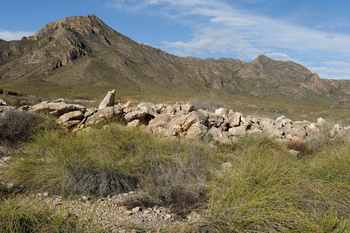 Since the arrival of the tomato and melon plantations, most of the economic activity in Cañada de Gallego has been centred on these products. Large companies export what they grow here, and there has also been a growth in related secondary industry such as chemical fertilizers and pesticides, plastics, structures and the machinery needed for the use of the greenhouses.
Since the arrival of the tomato and melon plantations, most of the economic activity in Cañada de Gallego has been centred on these products. Large companies export what they grow here, and there has also been a growth in related secondary industry such as chemical fertilizers and pesticides, plastics, structures and the machinery needed for the use of the greenhouses.
This activity has changed the face of the district and vast areas are now covered in greenhouses and plastic crop-growing infrastructure. While this has undoubtedly created a high level of employment and attracted an immigrant population to the area, the greenhouses are of course unattractive to look at, particularly when abandoned, as many of the older exploitations are.
At some point in the future the ugly seas of plastic may be replaced by holiday housing, as the area still has some of the most beautiful and unspoilt beaches within the municipality of Mazarrón. For the moment, though, the profitability of agricultural activity has saved 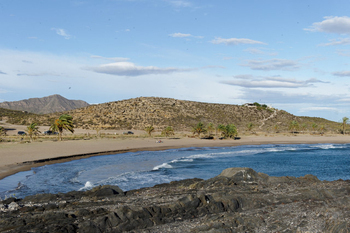 Cañadas de Gallego from tourist development.
Cañadas de Gallego from tourist development.
recently some of the large agricultural companies working in Mazarrón have started to switch operations to Morocco, labour costs being cheaper, so investment into the area has declined, but at the same time new crop strains are being trialled to develop new revenue streams for the future.
Beaches
Percheles is reckoned to be one of the most beautiful beaches in the Costa Cálida and is a glorious, sweeping sandy bay. Others, such as the wild and open beach of Cobaticas which stretches for an uninterrupted sandy kilometre is also a little visited gem, popular in the winter with wild campers vans, who find refuge behind the scrubby vegetation littering this coastline.
The whole of this coastal stretch between the boundary with Lorca and Bolnuevo on the outskirts of Puerto de Mazarrón is connected by a rough coastal track, and the Sierra de las Moreras offers many walking options.
Fiestas in Cañada de Gallego, Mazarrón
The fiestas in honour of the patron saint San Antonio de Padua take place around the Saint´s day on 13th June and are a relatively recent tradition, but are growing more popular by the year. As well as a Holy Mass and a religious procession there is also music, dancing and a firework display.
Property in Cañada de Gallego, Mazarrón
Due to the greenhouses this is not the prettiest of rural districts, and has very few mature properties due to its historically low population. There are a few tucked away in the countryside, but much of the existing population live within the village itself, which has a pharmacy, a medical centre, a social centre, a church, shops, bars and restaurants. For major shopping it is necessary to drive at least into Mazarrón.
Be aware that many beach-front properties may theoretically fall foul of the Ley de Costas, which restricts development along the coastline and may mean that theoretically structures ought to be demolished.
Location
For more local information including what's on, news and tips for visitors go to the home page of Mazarrón Today.
Sights to see in Mazarrón
